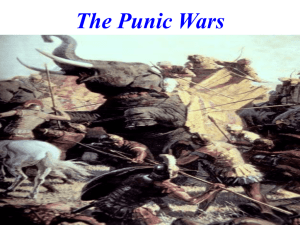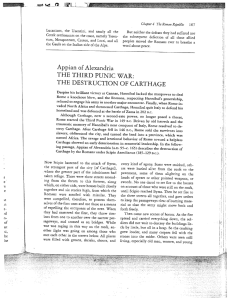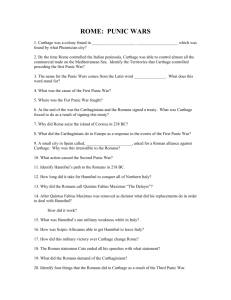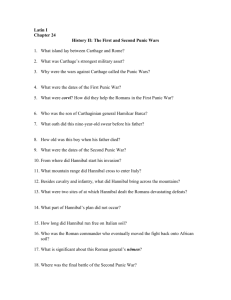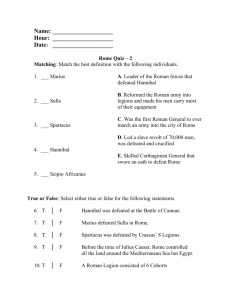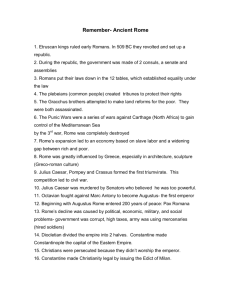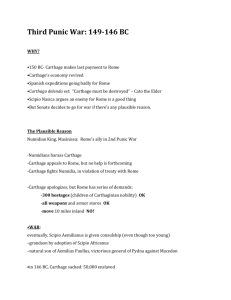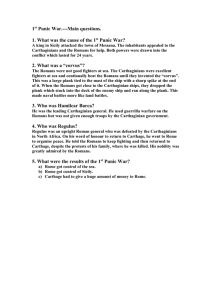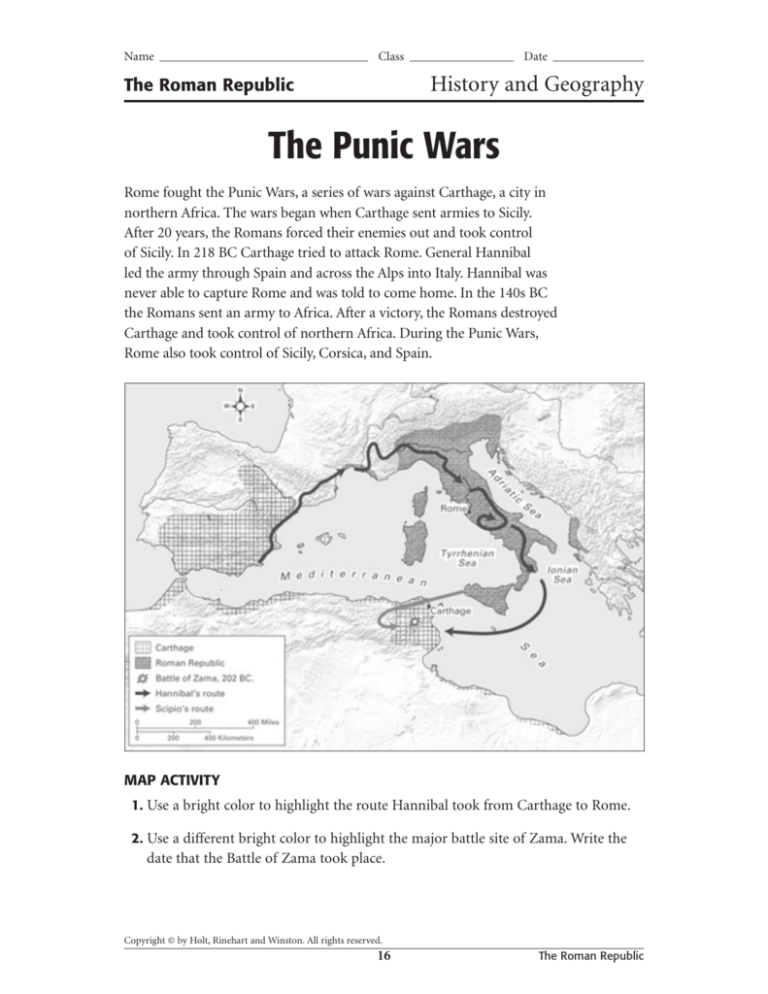
Name
Class
Date
History and Geography
The Roman Republic
The Punic Wars
Rome fought the Punic Wars, a series of wars against Carthage, a city in
northern Africa. The wars began when Carthage sent armies to Sicily.
After 20 years, the Romans forced their enemies out and took control
of Sicily. In 218 BC Carthage tried to attack Rome. General Hannibal
led the army through Spain and across the Alps into Italy. Hannibal was
never able to capture Rome and was told to come home. In the 140s BC
the Romans sent an army to Africa. After a victory, the Romans destroyed
Carthage and took control of northern Africa. During the Punic Wars,
Rome also took control of Sicily, Corsica, and Spain.
MAP ACTIVITY
1. Use a bright color to highlight the route Hannibal took from Carthage to Rome.
2. Use a different bright color to highlight the major battle site of Zama. Write the
date that the Battle of Zama took place.
Copyright © by Holt, Rinehart and Winston. All rights reserved.
16
The Roman Republic
Name
Class
Date
History and Geography
The Punic Wars, continued
3. What is the name of the mountain range that Hannibal and his armies crossed
before entering Rome? Label it on the map.
4. Update the map legend to reflect the colors you added to the map.
ANALYZING MAPS
1. Place Rome lies in what direction from Carthage?
2. Location What is the name of the large island directly off the southern tip of Italy
and north of Africa? Label this island on your map.
3. Region After Hannibal and his army landed in Spain, many miles did they travel
to get from Spain to Rome?
4. Movement Examine the map carefully. If you know that the Romans originally
settled around Rome, in what direction did they move to settle the rest of Italy?
Romans became good sailors, navigators, and traders. Color in areas of the map
where you predict the Romans may have expanded their empire.
Copyright © by Holt, Rinehart and Winston. All rights reserved.
17
The Roman Republic
Answer Key
Primary Source The Story
of Spartacus
Economics and History
WHAT DID YOU LEARN?
1.
2.
3.
4.
WHAT DID YOU LEARN?
1. Spartacus and his men had won many
battles against the Roman soldiers. By
this time, Crassus knew that the person
who finally defeated Spartacus would be a
famous hero.
2. They help to make a story more interesting, exciting, or memorable; they help to
make the hero seem special and not like
other people.
3. Possible answers: “wisely,” “of high
spirit,” “gentleness,” “valiant.” Plutarch’s
descriptions imply that he may have
admired or respected Spartacus.
4. Possible answers: Many people may have
admired Spartacus and what he did.
They may have liked the story because it
showed that someone like them had the
courage to fight against a mighty empire.
900,000; 300,000; 1,500,000
4,063,000;1,354,333; 6,771,667
6,944,000; 2,314,667; 11,573,333
The 5:3 slaves to citizens estimate would
most support the notion that the size of
the slave population, combined with the
potential for slave revolts, was one of the
factors that led to the fall of Rome.
Social Studies Skills
PRACTICE THE SKILL
1. the Rhine and Danube rivers
2. that it took some time before it was
complete
APPLY THE SKILL
1. none
2. the Nile River
3. coastal areas and (large) cities
History and Geography
Chapter Review
MAP ACTIVITY
REVIEWING VOCABULARY, TERMS,
AND PEOPLE
1. A bright color should highlight the route
from Carthage, through Spain, across the
Alps, and down toward Rome.
2. 202 BC
3. Alps
4. Colors will vary.
1.
2.
3.
4.
5.
ANALYZING MAPS
Aeneas
patricians
magistrates
legions
Spartacus
COMPREHENSION AND CRITICAL
THINKING
1. Place
north or northeast
2. Location
Sicily
3. Region
Approximately 1050–1100 miles (Because
of the curves, twists, and turns that
Hannibal took to get to Rome, an exact
measurement will be difficult.
4. Movement
generally north and south, or northwest
and southeast
Students should shade in areas of North
Africa, Spain, France, Northern Italy, and
Macedonia and Greece.
1.
2.
3.
4.
rivers
tripartite
Twelve
Romans took over Greece
Copyright © by Holt, Rinehart and Winston. All rights reserved.
33
The Roman Republic

